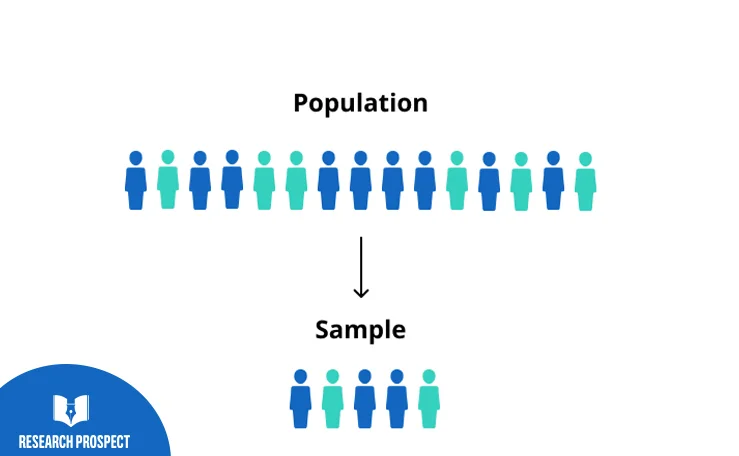Sampling Methods – A Guide with Examples
Published by at August 16th, 2021 , Revised On August 25, 2023
If you are performing research on a large community, organisation, or country, then it may not be possible to collect data individually from each participant. To deal with this issue, you can use a group of a specific number of participants, and this group is referred to as a sample.
The method you apply for selecting your participants is known as the sampling method. It helps in concluding the entire population based on the outcomes of the research.
Example:
If you want to research China’s entire population, it isn’t easy to gather information from 1.38 billion people. You can use a sampling method by conducting your research on a specific number of participants and drawing a conclusion about the entire population based on your study’s outcomes.
Uses of Sampling Method
The sampling method is used to:
- Gather data from a large group of population.
- Counter check on data collection.
- Speed up tabulation and publication of results.
- Increase the efficiency of the research.
- Conduct experimental research
- Obtain data for researches on population census.
What is the Difference between Population and Sample?
Before starting with the sampling methods, it is important to understand the difference between sample and population.
Sample
It is a group selected from the target population when you aim to study a large population. This group is considered as the representative of the overall targeted population.
Example:
Sample of 20 female cricketers.
Population
If you add the set of individuals with specific characteristics according to the research requirements, the resulting group is called the population.
Example:
The income of government teachers in India
Sampling Frame Vs. Sampling Size
Sampling Frame
A list of all the elements from a population is known as the sampling frame.
For instance, you are selecting a telephone directory of students or a list of social media users.
This information can be gathered by contacting any commercial organisation. Sometimes some errors are also possible in the sampling frame due to its discrepancy in selecting samples.
Sampling Size
It is considered a subset of the population as it is selected to make the inference to the original population of a study. The chances of accuracy are depended on the size of the population. The larger the size, the more accurate the study is.
When it comes to census, the sample size is the same or parallel with the population size. But to maintain the budget and to consider the time frame, only a representative class is selected.
Methods of Sampling
There are usually two methods of sampling which are used widely. These are considered the best methods:
- Probability Method
- Non-Probability Method
Probability Method
This method of sampling is conducted by using the method of randomisation. In this method, each individual has an equal and independent opportunity to be selected. It has further sub-categories.
- Simple Random Methods
- Stratified Methods
- Systematic Method
- Cluster Method
- Multi-Stage
What data collection best suits your research?
- Find out by hiring an expert from ResearchProspect today!
- Despite how challenging the subject may be, we are here to help you.
Simple Random Method
The participants are selected randomly and assigned to the experimental group. It is known as probability sampling. If the selection is not random, it’s considered non-probability sampling.
Example:
You want to identify how much time people spend on social media. You need to randomly select the participants and assign a specific number of hours to spend on social media.
Example: You want to find out the benefits of a balanced diet. You need to select the participants randomly and assign a balanced diet.
Systematic Sampling Method
In this type of sampling, method participants are selected according to the fixed period interval and starting point. The fixed period interval can be calculated by dividing the sample size by the respective population size.
Example:
Framingham study, which includes selecting every second person from a list of two residents.
Stratified Method
Stratified sampling is a random selection of the participants by dividing them into strata and randomly selecting the participants from each level.
Example:
You want to identify how much time people spend on social media. You need to divide the participants into groups based on their age and then assign a specific number of hours to spend on social media.
Example:
You want to find out the benefits of a balanced diet. You need to divide participants into various groups based on their age, gender, and health conditions and assigned them to each group’s treatment group.
Matching Method
Even though if participants are selected randomly, they can be assigned to the various groups of comparison. Another procedure for selecting the participants is ‘matching.’ The participants are selected from the controlled group to match the experimental groups’ participants in all aspects based on the dependent variables.
Cluster Sampling
It is a kind of sampling where the population is converted into sub-groups called clusters. These sub-groups or clusters are then selected randomly as a sample. The selected group should have all the characteristics of other groups.
Example:
You want to check high school students’ communication skills, and there are more than 50 schools in the city. You can’t visit each school to gather information. In such situations, you can select any five schools, and these schools will be your clusters.
Non-probability Sampling
Non-probability sampling techniques are often appropriate for exploratory and qualitative research. This type of sample is not to test a hypothesis about a broad population but to develop an initial understanding of a small or under-researched population.
This type of sampling is different from probability, as its criteria are unique. The samples are not selected randomly; rather, these samples are selected according to the researcher’s ability. This might result in a biased result, and participants may find it difficult to be a part of the sample. Still, this is a prevalent method. It has the following types:
- Purposive type sampling
- Referral sampling
- Convenience Sampling
- Quota Sampling
Reading material: ResearchProspect has also published a very detailed guide about inductive and deductive reasoning for students.
Purposive Sampling
This type of sampling is based on the aims of the research. Therefore, only such elements of the population will be selected, which are according to the research’s purpose.
Example:
You want to find out the opinion of people about jobs and businesses. You can select a few participants interested in doing 9-5 jobs and a few interested in doing business.
Referral Sampling
This type of sampling is used where the population is not defined or rare. In this technique, one participant is selected according to defined criteria. After that, the same selected participant is asked to refer to other samples fulfilling the study’s criteria. In this way, it goes enlarging its size with the help of the referral.
Example:
You can use it while conducting a study on the victims of physical harassment at workplaces. No matter how smoothly you approach them, not all women respond openly to your questions as they feel uncomfortable, or they get afraid of being humiliated. You can select the people from these victims’ circles (ex: their colleagues, friends, relatives) to get in touch with them and gather the required information for your research.
Convenience Sampling
This type of sampling is applied according to availability. If the samples are not available easily, and the research is getting costly, this technique is applied to select the samples as per convenience.
Example:
You want to research the election campaigns. In this situation, you need to gather information from the available candidates (political leaders, media persons, voters) whenever and wherever you get any chance to meet them; otherwise, you will need to wait for the next election campaign.
Quota Sampling
This type of sampling is done when some standards are already adjusted. In this sampling, the representatives are selected from the population. This selected sample should resemble all the characteristics traits of the population. The size of the sample should reflect the. The participants are selected until sufficient information is gathered.
Example:
You want to identify and compare the high school’s academic performance, and you are allowed to select only 100 participants as per the standards of your study. You can select 25 students of the ninth standard, 25 students of the tenth standard, 25 students of the eleventh standard, and 25 students of the twelfth standard.
Get statistical analysis help at an affordable price
We have:
- An expert statistician will complete your work
- Rigorous quality checks
- Confidentiality and reliability
- Any statistical software of your choice
- Free Plagiarism Report
Advantages of Sampling Method
Sampling has many advantages, such as:
- It saves a lot of time, as contacting the entire population would be difficult and time-consuming.
- It’s cost-effective.
- It has greater scope and adaptability.
- It provides accurate results.
- It can be managed easily.
Disadvantages of Sampling Method
- It may cause a feeling of discrimination among the participants who are not selected for the study.
- The researcher needs to be skilled, experienced, and qualified to ensure efficient sampling.
- It requires a lot of time, and results may not be reliable.
Frequently Asked Questions
Sampling is the process of selecting a subset of individuals or items from a larger population to gather data. Types include:
- Random Sampling: Each member has an equal chance.
- Stratified Sampling: Divides population into groups for proportional representation.
- Systematic Sampling: Every nth member is chosen.
- Cluster Sampling: Population is divided into clusters; random clusters are selected.
- Convenience Sampling: Convenient individuals are chosen.
- Snowball Sampling: Existing subjects refer new ones.



















